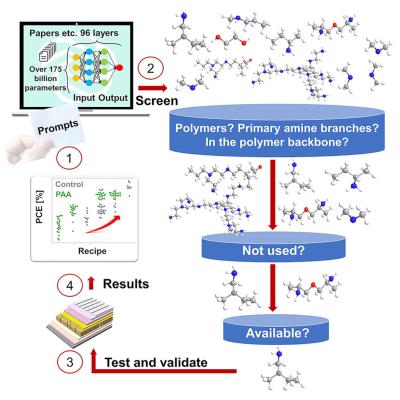Researchers from China's Nankai University and Linköping University in Sweden have attempted to design a perovskite solar cell with the help of ChatGPT. The experiment helped the team to identify a series of materials for the cell composition and the results were cells with a higher power conversion efficiency compared to that of reference cells built without the material proposed by ChatGPT.
The scientists explored ChatGPT's ability to generate hypotheses for material science and identify untested molecules capable of reducing surface recombination and thereby boosting the efficiency of perovskite solar cells.
To find molecules for surface passivation in hybrid perovskite solar cells with a p-i-n architecture, the group used ChatGPT 3.5, with a data cutoff in September 2021. Comparing their interaction with the chat model to brainstorming, the group said it was an ongoing dialog and exchange of questions and answers. Among requests they input into the large language model (LLM), for example, there was information on commercially available compounds, or at least easily synthesizable, reasonably priced, and not overly toxic.
However, ChatGPT could not do everything. The scientists manually verified the general plausibility of the suggested materials, later checking in academic databases whether they had already been explored. Through this process, they identified polyallylamine (PAA).
“PAA is a water-soluble biodegradable polymer with applications in areas such as medicine, nanoparticle synthesis, and heavy metal ions chelating,” the research group explained. “ChatGPT provided us with suggestions for other molecules as well, but based on price, availability, toxicity, structural similarity to other surface passivation, and a lack of previous reports using PAA for this purpose, we decided that PAA would be an interesting molecule to explore experimentally.”
Following up with a real-world experiment, the scientists fabricated 125 devices. The device structure followed a standard p-i-n architecture composed of a soda lime glass/indium tin oxide (SLG/ITO) substrate, a MeO-2PACz hole transport layer, a PCBM-60/BCP electron transport layer, and silver metal contact. The absorber was based on a triple cation Cs0.05FA0.91MA0.04PbBr0.15I2.85 perovskite with a band gap of 1.54 eV.
A thin layer of PAA was applied onto the perovskite film by spin coating before the deposition of the PCBM layer. In some of the experiments, the PAA solution was 0.015% in isopropyl alcohol (IPA), while in others, it was 0.025% or 0.05%. Control samples without PAA treatment were also manufactured.
The scientists reported that the average device performance increased by around 2 percent units, with a top performance of 22.75%, which offers a compelling demonstration of the value of human-AI collaboration.




